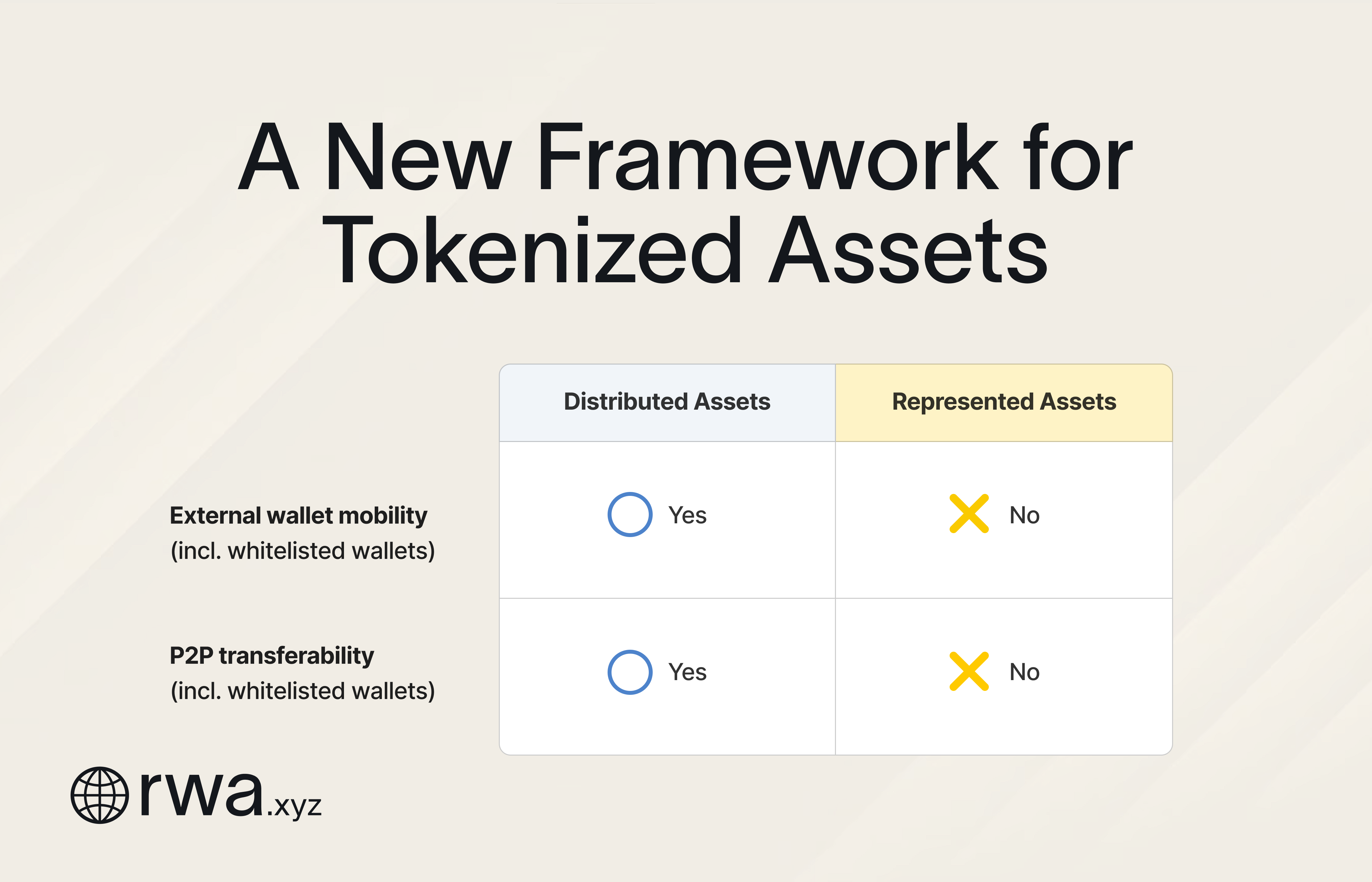Introducing a new way to classify tokenized assets.

TL;DR
When we first started RWA.xyz in 2023, the tokenized asset market was still in its infancy. Tokenized U.S. treasuries were just emerging, along with a small group of pioneers experimenting with tokenizing private credit, gold, and institutional funds. The space was small enough that you could practically name every product. Fast forward to today, there are now over 400 different tokenized assets listed on our platform, spanning use cases that weren’t even imaginable in the early days.
Tokenized assets are tokens on a blockchain that represent offchain assets such as financial instruments, commodities, and fiat currencies. Projects tokenize assets for a variety of reasons. Some use tokenization as a new channel for capital formation, while others use it to replicate traditional financial structures. Despite these differences, everything is still labeled a “tokenized asset”, an overly broad term that fails to capture the underlying nuance. The lack of a more precise definition creates confusion across the industry and fuels unproductive debates about what qualifies as a tokenized asset.
To address this problem, we worked closely with issuers and platforms across the market to identify two attributes that cut through the ambiguity: whether a token can be (1) moved to a wallet outside of the issuing platform, and (2) transferred peer-to-peer between wallets. Based on these criteria, we are introducing two new categories of tokenized assets: Distributed Assets and Represented Assets.

Distributed Assets are tokenized assets that can be moved to wallets outside the issuing platform and transferred between wallets, including those with whitelist or eligibility controls. The blockchain primarily serves as a new channel for capital formation, enabling issuers to reach a global investor base directly. Just as digital platforms reshaped the distribution and consumption of media, onchain capital markets are redefining the value chain by offering borderless, 24/7 access to investors.
The core value proposition centers on market reach, financial inclusion, and platform interoperability, benefits enabled by distributing assets to onchain investors. The name “Distributed Assets” highlights this defining feature.
Represented Assets are tokenized assets that cannot be moved to wallets outside the issuing platform or transferred between wallets, whether due to design or regulatory constraints. The blockchain primarily serves as a recordkeeping and reconciliation layer, modernizing legacy infrastructure and streamlining operations. Rather than expanding investor access, this model serves institutional participants seeking improvements to enhance their operational workflows.
The core value proposition centers on operational efficiency, improved reconciliation, and infrastructural upgrades, benefits enabled by representing assets on a shared ledger. The name “Represented Assets” highlights this defining feature.
Mobility and transferability matter because they unlock the full potential of tokenization: the ability to compose with other protocols and integrate with DeFi infrastructure. As more assets are distributed onchain, it is our hope that tokenization will deliver novel utility to users rather than replicating existing structures in a new format.
These categories aren’t meant to be static. We expect many Represented Assets to evolve into Distributed Assets over time, whether through market demand or regulatory clarity. Figure Technologies, for example, currently operates its tokenized HELOCs within its own lending marketplace but is working to make its broader portfolio of tokenized assets compatible with DeFi protocols. As these assets become movable and transferable, they will be reclassified as Distributed Assets.
This framework is now live across our platform and reflected in our market data. All tokenized asset league tables and time-series charts now offer three views: Distributed Assets, Represented Assets, and All Assets, with Distributed set as the default view. As a result, our headline market size figures may appear smaller not due to a market contraction, but because we have reclassified the following assets as Represented.

Note: Classifications are as of November 21, 2025 and may change as new information becomes available.
We developed this framework to create a better standard for the industry. One that enables productive dialogue and consistent analysis across products and platforms. As the market matures, we expect a convergence between these categories. Represented Assets may evolve toward broader distribution with regulatory clarity, while Distributed Assets may incorporate features to enhance operational resilience and compliance.
RWA.xyz remains committed to refining this framework to support the vision of a truly open and interoperable financial system. We welcome your feedback. Reach out to team@rwa.xyz.